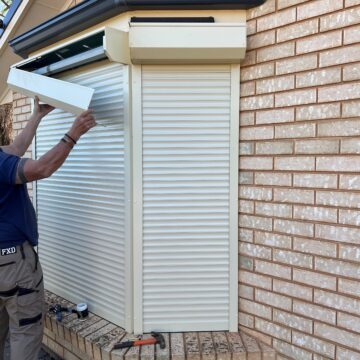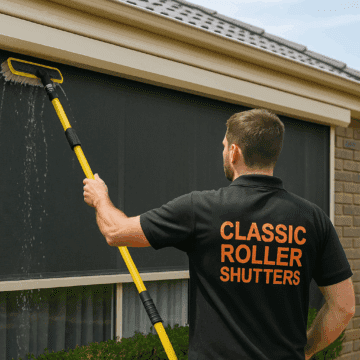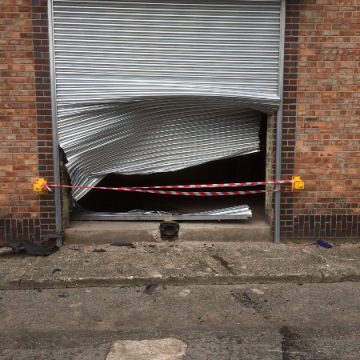In Australia, repairing a typical domestic roller shutter motor usually costs between $600 and $750 if you hire a technician/electrican. Need help with this call us 83692266.
Identify the Warning Signs of a Failing Motor
A spot-on diagnosis is the difference between a quick limit tweak and an unnecessary motor replacement. Before you think about roller shutter motor repair, spend ten minutes listening, feeling and testing—most faults leave clear clues if you know where to look.
Common Symptoms You Shouldn’t Ignore
- Grinding or rattling while the curtain moves – often a worn gear in 240 V tubular motors.
- A constant buzzing or humming but no rotation – the starter capacitor may have died.
- Shutter stops halfway up then drops a few centimetres – thermal overload or weak battery on 12 V systems.
- Head box becomes hot to the touch after one cycle – motor windings are struggling.
- Remote LED flashes yet nothing happens – RF receiver or low-volt controller has lost power.
- Manual override eyelet feels jammed – internal brake could be seized.
The exact sound or behaviour varies with motor type: wired 240 V units usually hum, whereas low-voltage and solar models tend to click or pulse as the controller retries the command.
Quick At-Home Tests to Confirm It’s the Motor – or call the experts on 83692266
| Probable Cause | Simple Test | Next Action |
|---|---|---|
| Dead power feed | Isolate circuit, plug a lamp into same socket/FCU | Restore supply or reset breaker |
| Failed wall switch/remote | Swap to spare remote or short live/active wires on switch | Replace controller if shutter runs |
| Stuck curtain vs weak motor | Pull manual override cord—if curtain glides, motor is weak | Order replacement motor |
| Blown fuse in battery pack | Check inline fuse with multimeter | Fit new 2 A fuse, retest |
| Overloaded thermal cut-out | Wait 15 min then retry | If it restarts, check guide friction |
A good multimeter and a clear photo of the wiring before you start are worth their weight in gold—no guessing which blue belongs where when it’s time to reassemble.
When It Might NOT Be the Motor
- Jammed side guides: aluminium swarf, wasp nests or bent rails create drag that mimics motor failure.
- Slipped curtain slats: the roll becomes uneven, triggering the motor’s torque limit. Realign and re-clip.
- Broken tapes or straps on older manual-convert units can stop the axle turning even though the motor runs fine.
- Seized axle bearings: a squeal at the very start of travel points to dry bearings, not electrics.
call one of our qualified, licensed and insured techs out for all your repair needs on 83692266
Parts, Labour & Hidden Extras
A $400 “special” motor can balloon beyond $650 once the following are factored in:
- Wall switch or RF remote upgrade ($45–$180)
- New E-Port or DC-10 controller on 12 V systems ($90–$160)
- Second-storey window or roller door? Scaffold/boom lift hire adds $120+ per day
- Mains isolation and compliance test by a licensed sparky (mandatory) ( $80–$150)
- Removal and recycling of the old motor ($15–$30)
Cheap no-name imports can shave $60 off the invoice, but many insurers class them as “non-compliant equipment”. If heat damage or an electrical fire occurs, a rejected claim will dwarf any upfront saving. We only install high quality motors and accessories at Classic, call us on 83692266 for all your repair work by a qualified, insured, licensed electrician. With an up-front quote.
Warranty & Insurance Considerations
Quality tubular motors in Australian homes typically run trouble-free for 10–20 years; choose a reputable European model and keep it clean, and 25 years isn’t unusual. (Source: internal service logs and PAA data). Budget units often limped back to our workshop in under five.
Check three documents before you pick up a screwdriver:
- Manufacturer warranty – opening the head box yourself may void it.
- Home-and-contents policy – All insurers require licensed electrical work for 240 V appliances.
- Builder’s hand-over pack (if the home is under structural warranty) – motor swaps can affect compliance certificates.
Match motor type to your existing controls:
- 240 V tubular – direct to mains, suits most wall switches and Somfy RTS receivers.
- 12 V low-voltage – pairs with OzRoll E-Port/DC-10, safer for DIY but slower.
- Battery or solar – includes Li-ion pack and panel; good for hard-to-wire lintels.
In South Australia—and most states—any new or altered fixed 240 V wiring must be tested and signed off by a licensed electrician under AS/NZS 3000:2018 Clause 2.6.3. DIYers can legally plug a low-voltage controller into a GPO, but hard-wiring a tubular motor yourself risks fines, refused insurance claims or worse. When in doubt, book an electrician for the final connection and compliance certificate.
Routine Maintenance Schedule
Quarterly
- Hose or brush dirt from guide channels and sill.
- Spray a light coat of silicone dry-lube into both guides while the curtain is raised.
Annually
- Operate the manual override or hand-crank to prevent seizure.
- Inspect hood screws and wall fixings; snug down if needed.
- If you run a 12 V battery system, perform one full discharge/charge cycle to keep cells balanced.
Every 3–5 years
- Book a service call for professional load testing and limit recalibration, especially if you rely on the shutter for bush-fire protection.
Stick to this checklist and a quality motor should cruise through 15 to 25 years of daily use with nothing more than an occasional button battery and a can of silicone spray—cheap insurance against another Saturday on the tools.
Know When to Call a Professional Technician
Even the best-laid DIY plans hit a wall sometimes. If the repair starts drifting into electrical hazards, structural risks or plain head-scratching frustration, stepping back and bringing in a qualified roller-shutter technician can save both money and skin. call 83692266
Red Flags That Demand Expert Help
- Sparks, burning smell or scorched insulation after reconnection
- Shutter jammed solid; you can’t budge it with the manual override
- Corroded or brittle wiring inside a pre-2000 head box
- Second-storey or roof-mounted shutters that need scaffold or boom-lift access
- Suspected asbestos lining behind a built-in box
- Commercial doors cycling more than 20 times a day (industrial duty motors and safety brakes required)
If any box above gets ticked, stop the job, isolate power and ring a pro—continuing can void insurance or cause serious injury.
How a Service Call Typically Works
- Technician arrives, confirms isolation and inspects shutter (10–15 min).
- With approval, swaps motor or controller on the spot—most vans carry 10 Nm to 40 Nm units.
- Performs limit setting, load test and electrical compliance check.
- Removes the old motor for recycling and issues parts/labour warranty paperwork. We will send you these or you can download it from our web site
Average time on site: 60–90 minutes; complex double shutters may stretch to two hours.
Dispose of Old Components & Keep Records
The job isn’t finished when the hood screws are tight. Dealing with the dead motor responsibly and logging what you’ve done safeguard both the planet and your wallet the next time a roller shutter motor repair crops up. At Classic We do this for you, the motor is returned to the manufacturer for safe disposal.
Environmentally Responsible Disposal
Tubular motors contain copper windings, steel and a small oil charge—perfect candidates for recycling, not landfill. Most SA councils run free e-waste drop-off days; otherwise hand the unit to your local scrap-metal yard and pocket a few dollars for the copper. Capacitors and lithium battery packs (from solar or 12 V systems) must be taken to a designated battery drop-point at Bunnings or Officeworks—never in the kerb-side bin, where they’re a fire risk. Cardboard packaging can go in the yellow lid, while clean aluminium slats can be bundled for metal recycling.
Key Takeaways & Next Moves
- Diagnose first: strange noises, overheating or mid-travel stalls often point to the motor, but jammed guides and torn straps can mimic the same symptoms.
- Gear up properly: the right torque motor, matching drive wheel, insulated tools and PPE turn a fiddly job into a straightforward one.
- Safety is non-negotiable: isolate power, tag the breaker and let a licensed sparky handle any fixed 240 V wiring. – we do this for you.
- Know your limits: second-storey access, burnt wiring or stubborn jams are best left to a qualified shutter technician.
Need genuine spare parts or prefer a factory-trained pro to sort it for you? Reach out to Classic Roller Shutters Adelaide for friendly advice, rapid repairs and solid warranties.




